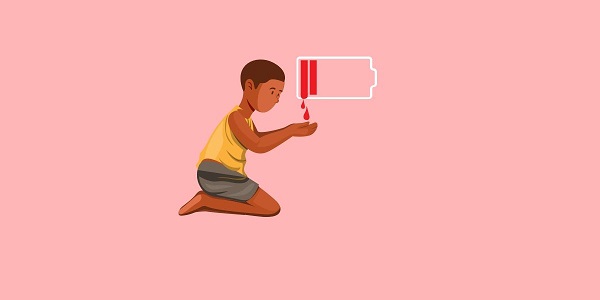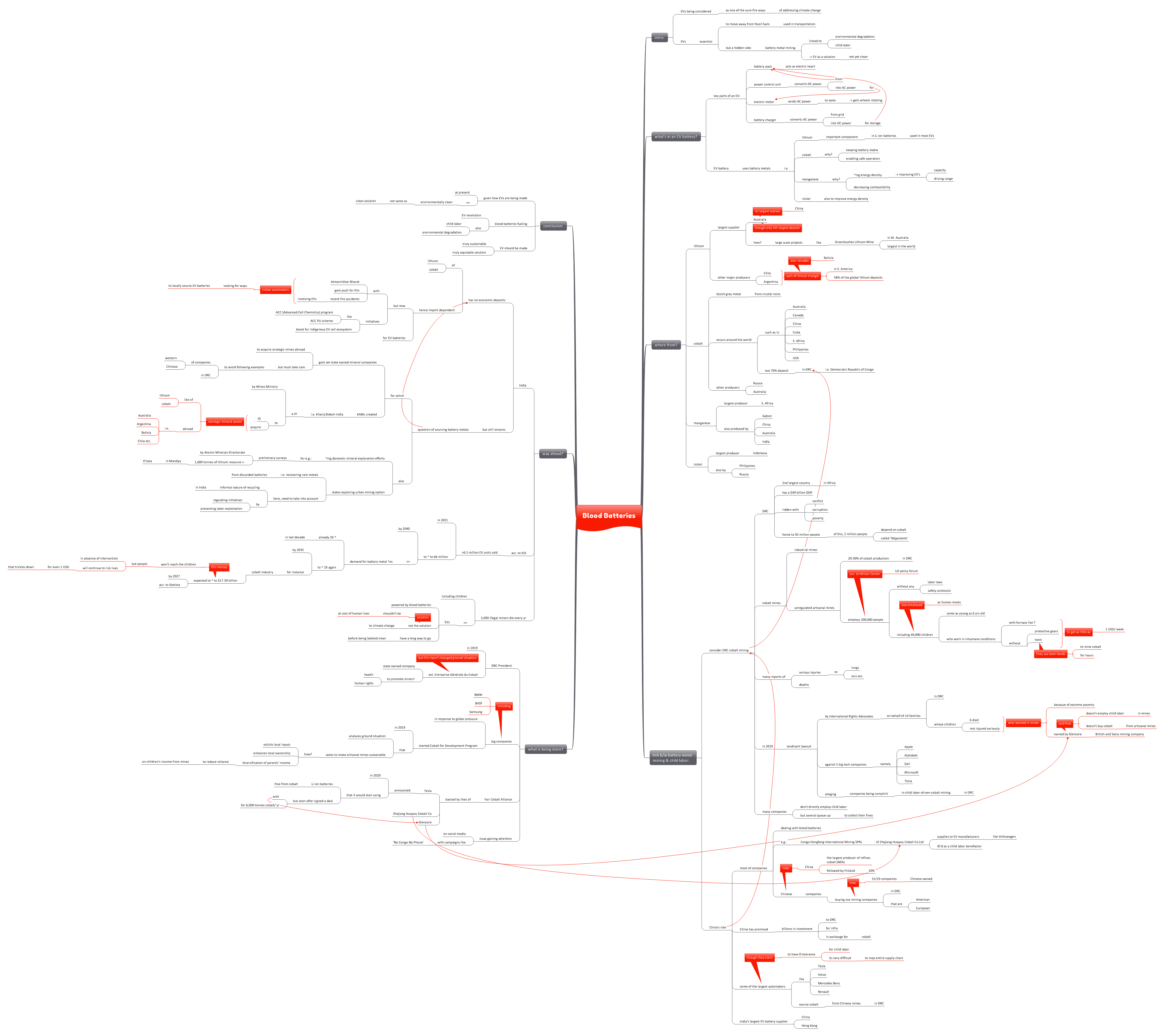Blood Batteries- Role of EV in Child Labour

The world is quickly turning to electric vehicles are one of the sure-fire ways of addressing climate change. India too is on this bandwagon. While EVs are essential for weaning the countries away from relying on fossil fuels for transportation, there is a hidden side to the story- that of battery metal mining. The mining of these metals involve not only environmental degradation, but also child labour- making EV a not so clean a solution as presented.
What goes into an EV battery?
- The key components of an electric vehicle are:
-
- A battery pack– functions as the vehicle’s electric heart
- Power control unit– coverts the DC power, stored in the battery pack, into AC power for the motor
- Electric motor– sends the AC power to the axles to get the vehicle’s wheels rotating
- Battery charger– converts the AC power from the electric grid into DC power for the battery pack during charging process
- Several metals go into making these batteries- lithium, cobalt, manganese and nickel. These are known as ‘battery metals’.
- Most of the EVs use Li-ion batteries.
- Cobalt is used to keep the battery stable and to enable safe operation.
- Manganese is noted for increasing the battery’s energy density, thereby improving the vehicle’s capacity and driving range. It is also used in decreasing the battery’s combustibility.
- Nickel is another ingredient used to improve the battery’s energy density.
Where do these metals come from?
Lithium
- Australia is the largest supplier of lithium, even though its lithium deposit is only the 5th largest in the world.
- This is thanks to mining projects like the Greenbushes Lithium Mine, considered as the world’s largest lithium mining project, in Western Australia.
- Notably, China is Australia’s largest lithium market.
- Other major lithium producers are Chile and Argentina– part of the Lithium Triangle which holds 58% of the global lithium deposits.
Cobalt:
- Cobalt is a bluish grey metal extracted from crustal rocks i.e. rocks found on the earth’s crust.
- It occurs around the world, in countries like Australia, Canada, China, Cuba, South Africa, the Philippines and USA.
- However, 70% of the global cobalt supply is from Democratic Republic of Congo.
- Other major producers are Russia and Australia.
Manganese:
- South Africa is the largest manganese producer.
- Other major producers include Gabon, China, Australia and India.
Nickel:
- Indonesia is the largest nickel producer.
- Philippines and Russia are other major producers.
How is battery metal mining linked to child labour?
The case of cobalt mining in DRC can be taken to understand the link:
- DRC is Africa’s 2nd largest country and has a $49 billion GDP. The country is ridden with conflict, corruption and poverty.
- Of the 92 million people who live in DRC, 2 million people depend on cobalt production. They are referred to as ‘Négociants’.
- While the country has industrial scale cobalt mining projects, some 20-30% of the metal is mined from the unregulated artisanal mines.
- These mines employ 200,000 people, but aren’t governed by labour laws or safety protocols. Some 40,000 of these people are children– some as young as 6 years old, according to Wilson Center (a US policy forum).
- These children are used to dig for cobalt in places that are inaccessible for the adult miners. They work in inhumane conditions with furnace-like temperatures.
- They aren’t given protective gear or even shovels to mine the metal. They typically dig for it with bare hands for hours, only to earn as little as a dollar/ week. They are sometimes employed as human mules for transporting the mined cobalt.
- There have been many reports of serious injuries (to the lungs and skin) and death of children employed in these mines.
- In 2019, a landmark lawsuit was filed by International Rights Advocates, on behalf of 14 families from DRC, against 5 large tech companies– Tesla, Apple, Alphabet, Dell and Microsoft.
- The lawsuit accused the tech giants of being complicit in the child labour-driven cobalt mining in DRC.
- Of these 14 families, 6 had lost their children to tunnel collapses while the rest saw their children affected by serious injuries, such as paralysis.
- These children had been forced by their family’s extreme poverty to work in mines owned by Glencore– a British and Swiss mining company.
- Glencore argued that it doesn’t employ child labour in its mines nor does it purchase cobalt from artisanal mines.
- Many of these children aren’t directly employed by such large companies. However, many companies queue up to collect their fines.
China’s Role:
- Notably, a significant majority of the companies dealing with blood batteries are Chinese. China is the largest producer of refines cobalt (66%). It is followed by Finland (at 10%).
- Over the years, Chinese companies have been buying out American and European mining companies in the DRC. In recent times, 15 out of 19 industrial mines in DRC fall under Chinese ownership.
- An example is the Congo Dongfang International Mining SPRL of Zhejiang Huayou Cobalt Co Ltd, which supplies to EV manufacturers like Volkswagen. It is one of the companies identified as a child labour benefactor.
- China has promised the country billions in investment for infrastructure in exchange for DRC cobalt.
- Some of the largest automakers, including Tesla, Renault, Mercedes Benz and Volvo source their cobalt from Chinese mines in the DRC. Even though they claim to have zero tolerance for child labour, it is very difficult to map the entire supply chain.
- Notably, China and Hong Kong are the largest suppliers of EV batteries to India.
What is being done to address this situation?
- In 2019, DRC President Tshisekedi established the Entreprise Générale du Cobalt, a state-owned company to promote miners’ health and human rights. However, this hasn’t changed the situation at the ground level.
- In response to global pressure, big companies, like BMW, BASF and Samsung, launched the Cobalt for Development Program in 2019. It is a program to analyse the ground-level situation and make the artisanal mines more sustainable. It solicits local inputs and enhances local ownership. One of its strategies is diversification of parents’ income source to reduce the families’ reliance of children’s income from mining.
- Another initiative of note is the Fair Cobalt Alliance. Notably, it is backed by Tesla, Zhejiang Huayou Cobalt Co and Glencore.
- In 2020, Tesla announced that it would start using cobalt-free Li-ion batteries in its cars. However, it soon concluded a deal with Glencore for 6,000 tonnes of cobalt/ year.
- The issue is gaining attention on social media and is seeing campaigns like ‘No Congo No Phone’ to protest the use of child labour in DRC’s cobalt mines.
What is the way ahead?
- India doesn’t have an economic deposit of cobalt or lithium. As a result, most of the EV batteries are imported.
- However, with the recent government push for Atmanirbhar Bharat and use of EVs, Indian automakers are looking to source the batteries locally.
- This demand has increased even more following the recent fire accidents involving EVs. Automakers are betting that locally manufactured batteries might be a safer option.
- Other recent initiatives that are seeing many takers are the ACC (Advanced Cell Chemistry) program and the ACC production linked incentive scheme. These are expected to boost the indigenous EV cell ecosystem.
- However, a question of sourcing the battery metals still remains. Towards this, the government has set several state-owned mineral companies on mission to acquire strategic mines abroad.
- In January, the Mines Ministry created KABIL (Khanij Bidesh India)– a joint venture company to identify and acquire lithium, cobalt and other strategic mineral assets in countries like Australia, Argentina, Bolivia and Chile.
- But care must be taken to avoid following the examples of Chinese and Western companies in DRC.
- The government is also stepping up domestic mineral exploration efforts. For instance, preliminary surveys by Atomic Minerals Directorate revealed the presence of 1,600 tonnes of lithium resource in Karnataka’s Mandya district.
- Meanwhile, states are examining the option of urban mining i.e. recovering rare metals from discarded EV batteries. However, given the informal nature of India’s recycling sector, care must be taken to regulate the initiatives and prevent labour exploitation.
- IEA reports that over 6.5 million EV units were sold in 2021. This is expected to increase to 66 million by 2040.
- Understandably, the demand for battery metals tripled in the past decade and is projected to double again by 2035. For instance, the cobalt industry is expected to swell up to $17.39 billion by 2027, according to Statista.
- None of this money will reach the children employed in DRC’s cobalt mines. However, in absence of intervention, people will continue to risk their lives for even that single dollar trickling down.
- As 2,000 illegal miners, including children, die in the DRC mines every year, there is a need to understand that EVs, powered by blood batteries, cannot be a solution to climate change.
- An answer to climate change shouldn’t be at the cost of human lives. EVs have a long way to go before getting the ‘clean’ label.
Conclusion:
Given the way EVs are being manufactured at present, it is to be understood that what is clean for the environment, may not be really clean. Blood batteries continue to power the EV revolution and also fuel child labour and environmental exploitation. Efforts are imperative to make EV a truly sustainable and equitable solution.
Practice Question for Mains
Comment on the link between battery metals and child labour. What can India do to address the issue? (250 words)
If you like this post, please share your feedback in the comments section below so that we will upload more posts like this.




very nice article for current affairs